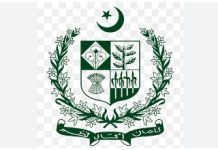Qamar Bashir
Former Press Secretary to the President
Former Press Minister to the Embassy of Pakistan to France
Former MD, SRBC
According to the World Bank’s latest estimates Pakistan GDP (Gross Domestic Products) Purchase Power Parity (PPP) level was $ 1.512 trillion USD in 2022 compared to nominal GDP of $ 348 billion. International Monetary Fund (IMF) data placed Pakistan as the 42nd (2022) largest economy in terms of nominal GDG and 23rd largest economy in the world in terms of GDP PPP level. It determined Pakistan’s share in the global economy at 1.1% and per capita income (PPP) at around $ 5680 (2022) against nominal per capita income of around $ 1658(2022), qualifying Pakistan in the middle income group countries. This figure was reached by adjusting for base year, age and size of the informal economy. According to the Quarterly Informal Economy Survey (QIES) by World Economics, London the size of Pakistan’s informal economy is estimated to be 35.6% which represents approximately $ 529 billion at GDP PPP level which is huge.
This by no means is a profile of a country which is currently facing extreme political polarisations and daunting financial challenges and economic challenges. Despite hyperinflations, dwindling foreign exchange, curb on imports of even raw material there is no visible impact of abject poverty especially in our urban centers. Customers are thronging the shopping areas, eateries are capacity-full, online commerce are thriving, wedding halls have been booked for years, and hotels are doing exceptionally well. So what is saving Pakistan from the impact of higher inflation? The answer could be the size of our massive informal economy, strong agricultural base, enterprising people, and numerous islands and motorways, both physical and virtual, created by the government and invented by the people to earn a decent living while avoiding stringent government rules and regulations and the sluggish public services.
This, most likely is one of the reasons why an outsider, such as Indian poet and writer Javed Akhtar did not witness any instances of poverty during his visit to Pakistan to attend a conference in Lahore last month (Feb,2023). When asked by an aggressive Indian host if he saw the impact of Pakistan’s worst financial and economic situation on the people of Pakistan, he responded emphatically in the negative. His response was intriguing and eye-opening. He stated that he saw abundance and prosperity, with no visible signs of poverty and destitution, as seen in India’s major cities in the form of beggary, slums, homeless people, and poverty and misery that can be seen on many deprived Indians.
During my time as Press Attache in Kuala Lumpur, Malaysia, and as Press Minister in Pakistan’s Embassy in France we traveled Europe and North America on motorways in complete safety and security. We traveled to Peshawar and Lahore shortly after our return and to our surprise, the quality of the motorways, rest and recreation areas, thick plantations on each side, and the presence of renowned international and national food chains at every stop with excellent restrooms, gas stations, repair shops, and restaurants at reasonable prices gave us the impression that we were traveling in a developed world country.
Similarly if you visit organized housing societies which are now thriving in every major and middle size town you will witness the civic facilities and neighborhood which rivals the developed world.
Pakistan possibly is the only developing nation that can boast more than nine world-class highways. Pakistan’s motorways, which are strategically located at the crossroads of South Asia, Central Asia, and the Middle East, provide much-needed access to regional markets as potential hubs for regional trade and investment. China’s One Belt One Road (OBOR) initiative, also known as the Belt and Road Initiative (BRI), is a global infrastructure and investment project launched by the Chinese government in 2013 to connect Asia, Europe, and Africa through a network of roads, railways, ports, and other infrastructure projects, promoting trade, investment, and connectivity. These vital arteries are providing much-needed connectivity within Pakistan and with regional and international countries. Under this project, approximately 888 kilometers of brand new motorways and highways have been constructed, with another 853 kilometers of world-class roads currently under construction. In the first phase, the completed motorways included KKH Phase II (Havelian – Thakot Section), Peshawar-Karachi Motorway (Multan – Sukkur Section), Hakla – D.I. Khan Motorway, and Orange Line Metro Train – Lahore. Moreover, package I of the Main Line-I (ML-I) railway upgrade project will be initiated in the middle of this year. New Gwadar International Airport, Pak-China Friendship Hospital, Gwadar East Bay Expressway, and Gwadar Technical & Vocational Institute have all been completed. Gwadar, Pakistan’s deep sea port on the Arabian Sea, is a key component of the China-Pakistan Economic Corridor (CPEC) and has the potential to become a major regional trade and transit hub. The government has made substantial investments in the development of Gwadar port and the associated infrastructure, including roads, railways, and pipelines, which will increase connectivity and facilitate trade with neighboring nations including China, Iran, and Afghanistan.
Eleven power projects totaling over 6,370 MW have been completed, 880 km of transmission lines have been installed, and projects totaling around 1200 MW are anticipated to be completed by 2023-2024 which will provide much needed power pivotal for socio-economic and industrial growth. Additionally, approximately 192,000 jobs have been created by CPEC investments and their secondary effects.
The CPEC has already entered its second phase, during which socioeconomic development, science and technology, agricultural cooperation, and industrialization will be the focus of cooperation. Of the agreed-upon 27 socioeconomic development projects, 17 fast-track projects have been initiated and are proceeding smoothly, while seven projects have been completed and five are in progress. During his most recent meeting of the outgoing Chinese ambassador, Mr. Nong Rong, the President Alvi expressed his satisfaction with the substantial progress made to complete the already commissioned projects, launching of new projects, and advancement made on the ML-1 project in order to accelerate the country’s development.
A marine highway is also about to be launched. In a meeting held in 2017 with Dr. Yahya Mahfoodh Salim Al-Manthri, President of the State Council of Oman, former Prime Minister Nawaz Sharif welcomed a proposal to start a ferry service between Karachi, Gwadar, and Muscat, the capital of Oman. Cabinet in 2020 approved establishing a shipping line with Iran and a few other states, as part of cooperation with Iran. During his recent meetings with the ambassador of Oman Al-Sheikh Dr Mohammed Omar Ahmed Al-Marhoon, President Dr. Arif Alvi emphasized that sea transportation would provide a viable mode of transport for Pakistani goods to other regions of the world, in addition to promoting tourism and the development of ports and resorts. Due to its strategic location, extensive coastline, and expanding shipping infrastructure, Pakistan has the potential to become a major player in the global shipping industry.
The people, because of their creativity, entrepreneurship and grit, and lack of employment opportunities in the country, have already developed the world’s fifth largest cyberspace motorway for themselves using online platforms. Startups and a large and growing pool of skilled IT professionals offer their services to clients all over the world in cyberspace by circumventing cumbersome procedures, protocols, and tedious and never-ending laws and regulations of Pakistan’s sluggish system. They are exploiting cyberspace motorways with total freedom, conducting a tremendous amount of business by selling their skills, expertise, and time to foreign buyers who are clamoring to take advantage of the high-quality. A whole new generation of young graduates and non-graduates with IT skills are earning a lot of money and pulling their families and the nation out of poverty. Upwork, Freelancer, Fiverr, Guru, PeoplePerHour, Toptal, 99designs, SimplyHired, FlexJobs, and LinkedIn Profinder are among the many online freelancing sites with specialized niches and uses depending on the field of expertise and the type of work. The Pakistan Software Export Board (PSEB) estimates that there are approximately 300,000 independent freelancers in Pakistan. Seventy percent of these are IT professionals, remaining are professionals who offer services such as content writing, translation, virtual assistantship, sales, marketing, account, finance, and customer service. According to the report, the country earned approximately $1.3 billion (Rs. 358 billion) in 2020 from freelance services, a significant increase from the $1.2 billion earned in 2019. This indicates that the cyberspace freelancing highway is expanding rapidly, with IT professionals playing a significant role in this expansion.
Pakistan’s cyberspace trade and commerce superhighway is rapidly expanding around the globe. Small merchants and entrepreneurs are utilizing online platforms to overcome some of the obstacles they face with conventional businesses and to unlock new growth opportunities. Increased internet and mobile phone penetration, as well as the availability of e-commerce platforms and marketplaces, make the prospectus not only promising but revolutionary. According to a report by the Pakistan Telecommunication Authority (PTA) in 2021, the total value of e-commerce transactions in Pakistan was approximately Rs. 96.4 billion (approximately $600 million) in 2020, representing a substantial increase from Rs. 39.2 billion (approximately $240 million) in 2017. It is estimated that the e-commerce sector in Pakistan employs approximately 200,000 people, including those in logistics, warehousing, and customer service. This number is anticipated to increase as the e-commerce industry continues to grow and generate new employment opportunities.
Pakistan’s nominal economy is still in ICU, it is showing signs of life though full recovery will take time, the informal economy is still surviving and keeping the people alive and able to survive the stringent and lethal impact of inflation, which has been accelerated to 36.4% in April of 2023, the highest reading since December of 1973.
The massive size of the informal economy is not a source of pride, but rather a sign of economic management failure. We must create enabling conditions to reduce the size of the informal economy in order to obtain a true reflection of the country’s economic outlook, while also taking concrete steps to retain our human intellect within the country and use it as a multiplier to bring creativity, innovation, and entrepreneurship to the country.
However, this would necessitate a multifaceted approach that includes policy interventions, institutional reforms, and targeted initiatives such as encouraging informal businesses to formalize by providing incentives such as tax breaks, credit, and other benefits, simplifying regulations and making it easier for informal businesses to register and comply with regulations, strengthening institutions such as tax authorities, courts, and law enforcement agencies to enforce regulations. This also includes investing in education and skill development to equip the workforce with the skills needed to succeed in formal sector jobs and encourage entrepreneurship and innovation by providing training, mentoring, and funding to aspiring entrepreneurs. It would also require addressing corruption at all levels of government and society to promote a level playing field for all businesses and restoring public trust in institutions and improving infrastructure across the country, particularly in rural areas, such as roads, bridges, and telecommunications to reduce transportation costs and increase connectivity.
The journey is long, but with the right approach and direction, we will be able to cross one mile stone after another until we arrive at our destination.

















